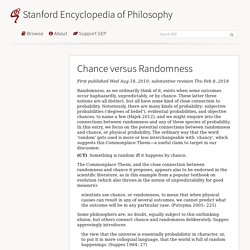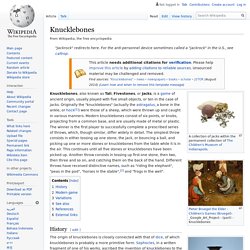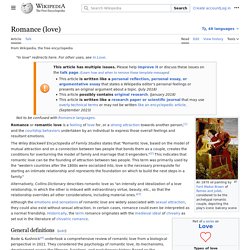

Chance versus Randomness. 1.

Chance To get clear on the connections and differences between chance and randomness, it would be good first to have some idea of what chance and randomness amount to. Interestingly, philosophical attention has focussed far more on chance than randomness. This may well be a consequence of the Commonplace Thesis. Whatever its source, we can appeal to a substantial consensus in the philosophical literature as to what kind of thing chance must be. Coupdedes. Pari de Pascal.
3 manières de calculer les probabilités. Huizinga. Jeu de hasard. Le terme jeu de hasard désigne également les jeux d'argent, les jeux de grattage comme les machines à sous.

La plupart de ces derniers sont des jeux de hasard pur ou raisonné. L'étude des problèmes de stratégie dans les jeux a donné naissance à une théorie mathématique : la théorie des jeux. Historique[modifier | modifier le code] Machine à sous fabriquée en 1928. Knucklebones. History[edit] The second, probably derivative, form of the game was one of pure chance, the stones being thrown upon a table, either from the hand or from a cup, and the values of the sides upon which they fell were counted.

The shape of the pastern bones used for astragaloi as well as for the tali of the Romans, with whom knucklebones was also popular, determined the manner of counting.[2] GRATUIT - Tarot Denis Lapierre - Divitarot.com - TAROT - divitarot - Tarot divinatoire gratuit - Tarot de Marseille - Tarot Denis Lapierre - TAROT - divitarot - Denis Lapierre - Tirage tarot de marseille gratuit immédiat. Tarot gratuit. Tarot online. Taro. Sans titre. Perlin noise. Two-dimensional slice through 3D Perlin noise at z=0 Perlin noise is a type of gradient noise developed by Ken Perlin in 1983 as a result of his frustration with the "machine-like" look of computer-generated imagery (CGI) at the time.[1] He formally described his findings in a SIGGRAPH paper in 1985 called An image Synthesizer.[2] In 1997, Perlin was awarded an Academy Award for Technical Achievement for creating the algorithm.[3][4] To Ken Perlin for the development of Perlin Noise, a technique used to produce natural appearing textures on computer generated surfaces for motion picture visual effects.

The development of Perlin Noise has allowed computer graphics artists to better represent the complexity of natural phenomena in visual effects for the motion picture industry. Perlin did not apply for any patents on the algorithm, but in 2001 he was granted a patent for the use of 3D+ implementations of simplex noise for texture synthesis. Uses[edit] Development[edit] Algorithm detail[edit] Input vs Output randomness. Glad to see more discussion about input and output randomness.

As an Ameritrash player who's played too many dungeoncrawlers, I see output randomness there for *entertainment*. By making an outcome uncertain, there's some tension added to the game. Otherwise, the game can become boring. If you've played RPG's, you're probably familiar with the saying, "I hit it", which basically means, "I don't care about this combat", suggesting that the player wants to skip this encounter and go to the next one. Most Ameritrash games have output randomness in the "bright red" zone, rather than dark. The Two Types of Random. Histoire du couple - Ép. 1/5 - Sexualité et société (2e volet) En partenariat avec Le Quotidien du médecin Nous débutons notre première série « Sexualité et société » avec Jean-Claude Bologne, philologue, historien, auteur de Histoire du couple (Perrin) qui nous décrira les variations des formes de couples depuis l’Antiquité : mariage, concubinage, association libre jusqu’au PACS ou au «mariage pour tous», maintenant que le cœur parle plus et que les arrangements faits par les parents, les passations de patrimoine ou les convenances passent au second plan : pourquoi se mettre en couple ?

Dans tous les modèles de l'Antiquité on ne propose pas le mariage à tous de la même façon. On propose le mariage légitime (la forme la plus stable et la plus solennelle du couple) à des jeunes femmes de bonnes familles auxquelles il serait absolument impossible de proposer un concubinage ou une forme dévalorisée d'union. Romance (love) Type of love that focuses on feelings Romance is an emotional feeling of love for, or a strong attraction towards another person, and the courtship behaviors undertaken by an individual to express those overall feelings and resultant emotions.

The word "romance" comes from the French vernacular where initially it indicated a verse narrative. The word was originally an adverb of Latin origin, "romanicus," meaning "of the Roman style". European medieval vernacular tales, epics, and ballads generally dealt with chivalric adventure, not bringing in the concept of love until late into the seventeenth century. The word romance developed other meanings, such as the early nineteenth century Spanish and Italian definitions of "adventurous" and "passionate," which could intimate both "love affair" and "idealistic quality.
" One example of the changes experienced in relationships in the early 21st century was explored by Giddens regarding homosexual relationships. Individualisme. Cet article a besoin d'un nouveau plan(22 mai 2019).

The triangular theory of love is a theory of love developed by Robert Sternberg, a member of the Psychology Department at Yale University.

During his time as a professor, Sternberg emphasized his research in the fields of intelligence, creativity, wisdom, leadership, thinking styles, ethical reasoning, love, and hate. In the context of interpersonal relationships, "the three components of love, according to the triangular theory, are an intimacy component, a passion component, and a decision/commitment component. Hannah Fry: The mathematics of love. Why i dont have a girlfriend. OkCupid. Powering Tinder® — The Method Behind Our Matching. We’re constantly asked about Tinder’s algorithm.

How are recommended profiles ordered, and why? Is there a way to game the system to get more matches? And is there really something called an “Elo Score?” While we cannot disclose all of our secret sauce, we thought it was about time that we share the main ingredients. What Really Matters Allow us to blow your minds. We prioritize potential matches who are active, and active at the same time. Untitled. Sans titre. Sans titre.